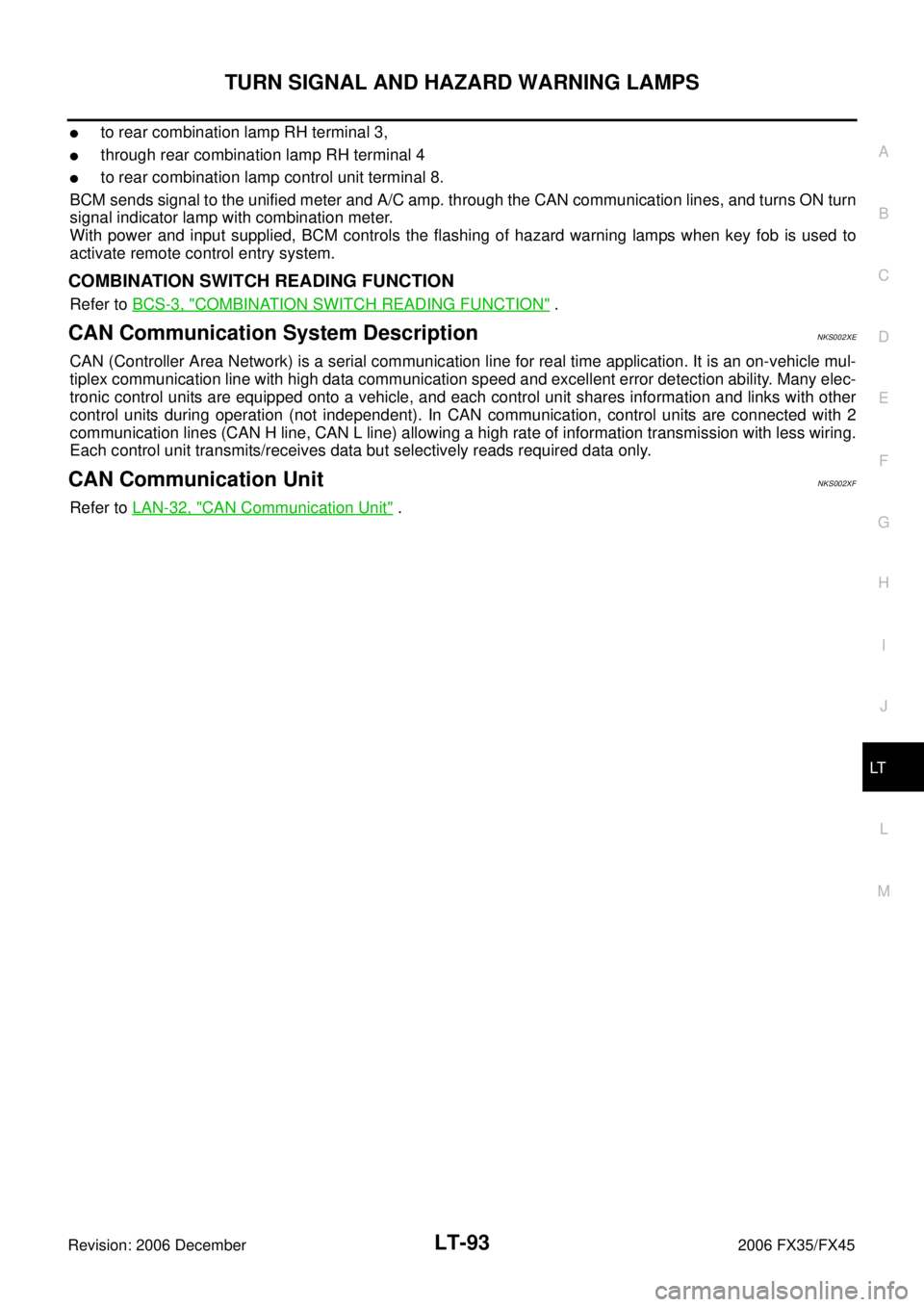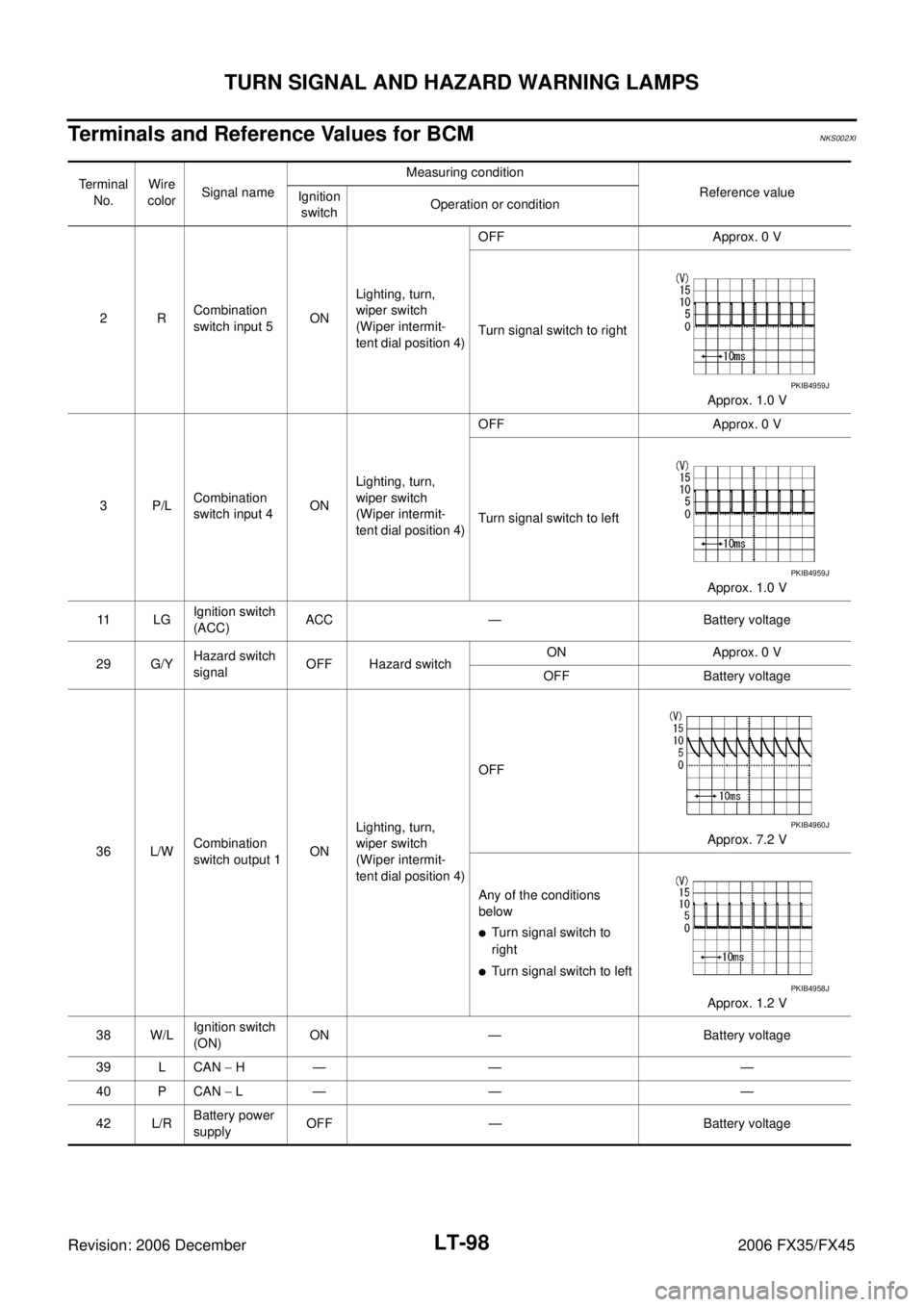Page 3653 of 4462

TURN SIGNAL AND HAZARD WARNING LAMPS LT-91
C
D E
F
G H
I
J
L
M A
B
LT
Revision: 2006 December 2006 FX35/FX45
Connected from BCM terminal 45 to front combination lamp LH terminal 4.
Turn signal lamp turns ON
�through front combination lamp LH terminal 8
�to grounds E21, E50 and E51.
Connected from BCM terminal 45 to rear combination lamp control unit terminal 4.
Rear turn signal (LED) turns ON
�through rear combination lamp control unit terminal 11
�to rear combination lamp LH terminal 3,
�through rear combination lamp LH terminal 4
�to rear combination lamp control unit terminal 10.
BCM sends signal to the unified meter and A/C amp. through CAN communication lines, and turns ON turn
signal indicator lamp with combination meter.
When rear turn signal lamp (LED) does not turn ON, rear combination lamp control unit sends signal to combi-
nation meter. And then unified meter and A/C amp. ends turn LED burnout status signal to BCM through CAN
communication lines for speeding up turn signal blinking.
RH Turn Signal Lamp
When the turn signal switch is moved to right position, BCM output turn signal from BCM terminal 46, interpret-
ing it as turn signal is ON.
Connected from BCM terminal 46 to front combination lamp RH terminal 4.
Turn signal lamp turns ON
�through front combination lamp RH terminal 8
�to grounds E21, E50 and E51.
Connected form BCM terminal 46 to rear combination lamp control unit terminal 5.
Rear turn signal (LED) turns ON
�through rear combination lamp control unit terminal 9
�to rear combination lamp RH terminal 3,
�through rear combination lamp RH terminal 4
�to rear combination lamp control unit terminal 8.
BCM sends signal to the unified meter and A/C amp. through CAN communication lines, and turns ON turn
signal indicator lamp with combination meter.
When rear turn signal lamp (LED) does not turn ON, rear combination lamp control unit sends signal to combi-
nation meter. And then unified meter and A/C amp. ends turn LED burnout status signal to BCM through CAN
communication lines for speeding up turn signal blinking.
HAZARD LAMP OPERATION
Power is supplied at all times
�through 50A fusible link (letter M, located in fuse, fusible link and relay box)
�to BCM terminal 55,
�through 10A fuse [No. 19, located in fuse block (J/B)]
�to combination meter terminal 8,
�through 10A fuse [No. 20, located in fuse block (J/B)]
�to rear combination lamp control unit terminal 1.
Ground is supplied
�through BCM terminals 49 and 52
�to grounds M35, M45 and M85,
�through rear combination lamp control unit terminal 7
�to grounds E21, E50 and E51,
�through combination meter terminals 5, 6 and 15
�to grounds M35, M45 and M85.
When hazard switch is depressed, ground is supplied
�to hazard switch terminal 2
�through BCM terminal 29,
Page 3654 of 4462

LT-92
TURN SIGNAL AND HAZARD WARNING LAMPS
Revision: 2006 December 2006 FX35/FX45
�to grounds M35, M45 and M85
�through hazard switch terminal 1.
When the hazard switch is depressed, BCM output turn signal from BCM terminals 45 and 46, interpreting it as
turn signal is ON.
Connected from BCM terminal 45 and 46 to front combination lamp RH and LH terminals 4.
Turn signal lamp turns ON
�through front combination lamp RH and LH terminals 8
�to grounds E21, E50 and E51.
Connected form BCM terminals 45 and 46 to rear combination lamp control unit terminals 4 and 5.
Rear turn signal (LED) turns ON
�through rear combination lamp control unit terminal 11
�to rear combination lamp LH terminal 3,
�through rear combination lamp LH terminal 4
�to rear combination lamp control unit terminal 10,
�through rear combination lamp control unit terminal 9
�to rear combination lamp RH terminal 3,
�through rear combination lamp RH terminal 4
�to rear combination lamp control unit terminal 8.
BCM sends signal to the unified meter and A/C amp. through CAN communication lines, and turns ON turn
signal indicator lamp with combination meter.
When rear turn signal lamp (LED) does not turn ON, rear combination lamp control unit sends signal to combi-
nation meter. And then unified meter and A/C amp. ends turn LED burnout status signal to BCM through CAN
communication lines for speeding up turn signal blinking.
REMOTE CONTROL ENTRY SYSTEM OPERATION
Power is supplied at all times
�through 50A fusible link (letter M, located in fuse, fusible link and relay box)
�to BCM terminal 55,
�through 10A fuse [No. 19, located in fuse block (J/B)]
�to combination meter terminal 8,
�through 10A fuse [No. 20, located in fuse block (J/B)]
�to rear combination lamp control unit terminal 1.
Ground is supplied
�to BCM terminals 49 and 52
�through grounds M35, M45 and M85,
�to rear combination lamp control unit terminal 7
�through grounds E21, E50 and E51,
�to combination meter terminals 5, 6 and 15
�through grounds M35, M45 and M85.
When the remote control entry system is triggered by input from key fob, BCM output turn signal from BCM
terminals 45 and 46, interpreting it as turn signal is ON.
Connected from BCM terminals 45 and 46 to front combination lamp RH and LH terminals 4.
Turn signal lamp turns ON
�through front combination lamp RH and LH terminals 8
�to grounds E21, E50 and E51.
Connected form BCM terminals 45 and 46 to rear combination lamp control unit terminals 4 and 5.
Rear turn signal (LED) turns ON
�through rear combination lamp control unit terminal 11
�to rear combination lamp LH terminal 3,
�through rear combination lamp LH terminal 4
�to rear combination lamp control unit terminal 10,
�through rear combination lamp control unit terminal 9
Page 3655 of 4462

TURN SIGNAL AND HAZARD WARNING LAMPS LT-93
C
D E
F
G H
I
J
L
M A
B
LT
Revision: 2006 December 2006 FX35/FX45
�to rear combination lamp RH terminal 3,
�through rear combination lamp RH terminal 4
�to rear combination lamp control unit terminal 8.
BCM sends signal to the unified meter and A/C amp. through the CAN communication lines, and turns ON turn
signal indicator lamp with combination meter.
With power and input supplied, BCM controls the flashing of hazard warning lamps when key fob is used to
activate remote control entry system.
COMBINATION SWITCH READING FUNCTION
Refer to BCS-3, "COMBINATION SWITCH READING FUNCTION" .
CAN Communication System DescriptionNKS002XE
CAN (Controller Area Network) is a serial communication line for real time application. It is an on-vehicle mul-
tiplex communication line with high data communication speed and excellent error detection ability. Many elec-
tronic control units are equipped onto a vehicle, and each control unit shares information and links with other
control units during operation (not independent). In CAN communication, control units are connected with 2
communication lines (CAN H line, CAN L line) allowing a high rate of information transmission with less wiring.
Each control unit transmits/receives data but selectively reads required data only.
CAN Communication UnitNKS002XF
Refer to LAN-32, "CAN Communication Unit" .
Page 3656 of 4462
LT-94
TURN SIGNAL AND HAZARD WARNING LAMPS
Revision: 2006 December 2006 FX35/FX45
SchematicNKS002XG
TKWM4305E
Page 3657 of 4462
TURN SIGNAL AND HAZARD WARNING LAMPS LT-95
C
D E
F
G H
I
J
L
M A
B
LT
Revision: 2006 December 2006 FX35/FX45
Wiring Diagram — TURN —NKS002XH
TKWM4306E
Page 3658 of 4462
LT-96
TURN SIGNAL AND HAZARD WARNING LAMPS
Revision: 2006 December 2006 FX35/FX45
TKWM4307E
Page 3659 of 4462
TURN SIGNAL AND HAZARD WARNING LAMPS LT-97
C
D E
F
G H
I
J
L
M A
B
LT
Revision: 2006 December 2006 FX35/FX45
TKWM4308E
Page 3660 of 4462

LT-98
TURN SIGNAL AND HAZARD WARNING LAMPS
Revision: 2006 December 2006 FX35/FX45
Terminals and Reference Values for BCMNKS002XI
Terminal No. Wire
color Signal name Measuring condition
Reference value
Ignition
switch Operation or condition
2R Combination
switch input 5 ON Lighting, turn,
wiper switch
(Wiper intermit-
tent dial position 4) OFF Approx. 0 V
Turn signal switch to right Approx. 1.0 V
3P/L Combination
switch input 4 ON Lighting, turn,
wiper switch
(Wiper intermit-
tent dial position 4) OFF Approx. 0 V
Turn signal switch to left Approx. 1.0 V
11 L G Ignition switch
(ACC) ACC — Battery voltage
29 G/Y Hazard switch
signal OFF Hazard switch ON Approx. 0 V
OFF Battery voltage
36 L/W Combination
switch output 1 ON Lighting, turn,
wiper switch
(Wiper intermit-
tent dial position 4) OFF
Approx. 7.2 V
Any of the conditions
below
�Turn signal switch to
right
�Turn signal switch to left
Approx. 1.2 V
38 W/L Ignition switch
(ON) ON — Battery voltage
39 L CAN − H— — —
40 P CAN − L— — —
42 L/R Battery power
supply OFF — Battery voltage
PKIB4959J
PKIB4959J
PKIB4960J
PKIB4958J